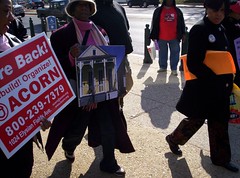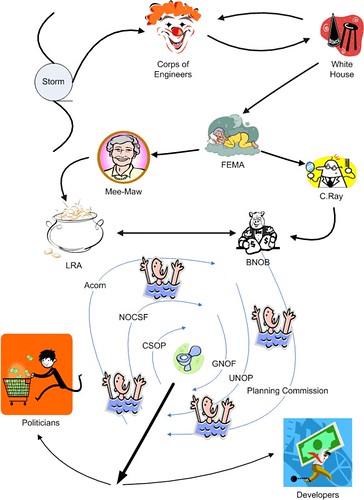Tyranny of Process in New Orleans
 ACORN Protest on New Orleans, near the Hart Senate Office Building in DC, February 2006.
ACORN Protest on New Orleans, near the Hart Senate Office Building in DC, February 2006.I haven't been keeping up with New Orleans as much lately. They are getting a barrage of planning though. And one of the entities being forced upon them is America Speaks, the nonprofit public participation/civic engagement contractor.
I am not a fan. To my way of thinking, organizations like America Speaks are into producing a seeming consensus and making the numbers--getting larger numbers of participants, especially of traditionally underrepresented demographics, without being committed to participatory democracy, or real deliberation and engagement. Democracy is messy and more than just being counted.
One of these days I plan to write more about the work of John Friedmann, author of Planning in the Public Domain and many other books and journal articles about radical planning practice. He has produced a great diagram showing the structure of the "state" in terms of politics and planning.
He differentiates between system maintenance, system change, and system transformation.
Maintenance is about bureaucracy and keeping things as they are. Transformation is about challenging the way things are, by working through political means. But ultimately, all change is about maintaining the political system, which occurs through the integration of change.
At first proposals are radical but get bounded and mediated in the process of getting adopted. In the end, radical becomes bureaucratic! (Reading Friedmann often depresses me because I joke to myself that I am merely working to reduce the most blatant excesses of the system and the Growth Machine.)
It occurs to me that America Speaks and similar organizations are more about mediating discourse, and limiting the possibility of transformation. Most of the elite see little need for transformation and radical practice. (In Friedmann's model, radical practice challenges what is done, but unlike revolutionary practice, it doesn't challenge the state as the ultimate expression of the people.)
Unless they insist on a commitment to unconstrained participation in their terms of engagement, by "working within, taking orders from, and legitimating the powers that be" public participation firms usually assist in the narrowing of discouse, constraining the parameters of democracy, and certainly limiting creativity and innovation and the possibilities and vision that should be on the table. But in the end, the contracting agency still gets to check off the box for public participation.
See this previous blog entry for a discussion of America Speaks and their involvement in the recent DC Library Planning process:
-- DC Library Planning and Listening Session: A Bit on Last Night.
It's merely a different form of treating citizens as customers or irritants, rather than as the drivers of the process, the source of the power and authority for all government.
This comes from the African-American Leadership Project, and while I think the color that matters most is green, rather than white or black, when it comes to land use and development issues, this bears reading:
First:
I just wanted to alert you to an opportunity to participate in development of a plan for rebuilding New Orleans. America Speaks has evidently received a contract to hold a series of citizen summits in approximately five different cities including New Orleans, BatonRouge, Atlanta, Houston, etc. They are now recruiting facilitators for these summits. If you are interested or for more information, please go to their website or contact Susanna Haas Lyons. Deadline for application is November 17.
The response from Mtangulizi Sanyika, AALP Project Manager, (832-830-8155):
Beware the enclosed forwarded e-mail. Despite its smooth language and apparent good intent, this is a disguised effort of the so-called "unified plan" advocates supported by the power elites and funded by the Greater New Orleans Foundation and the Rockefeller Foundation. A better use of the $5.5M in Foundation resources may have been to strengthen the capacity of local government and to allocate funds directly to neighborhood groups for implementation.
No matter what this group says or thinks it is doing, its ultimate effect is to undermine the recently completed neighborhood planning process initiated by the citizens in the devastated areas of the city, with the formal support of the City Council and the Mayor. Those Neighborhood Rebuilding Plans developed by the citizens were recently adopted by a 7-0 vote of the Council and will now be forwarded to the Louisiana Recovery Authority (LRA) for funding.
We in the AALP previously supported the Neighborhood and City Council planning process and regard these so called rebuilding summits as more game playing by the elites who seek to re-imagine the city in their richer, whiter, smaller image. They also wish to capture the billions in federal funding that were allocated to the LRA based on the devastation experienced by New Orleans neighborhoods. It is immoral and probably illegal as well to grant these funds to the non flooded areas. Furthermore, the views of dispersed Orleaneans in the listed cities have already been included in the "approved" Neighborhood Rebuilding Plans developed by the citizens; Thus making these gatherings redundant and unnecessary.
At the 1st of these meetings last week in New Orleans, about 200 folks attended, 80% of whom were white, upper income and from uptown. The emphasis of a local press article was on the conclusion that "footprint reduction" was a primary concern of this gathering. Contrast that with the citizen driven Neighborhood planning process which attracted thousands of participants from 49 different neighborhoods, over 9 months representing all areas of the city, including all races and income categories (i.e. the 9th ward, the East, Gentilly Lakeview, Central City, the 7th ward, Treme, Hollygrove, Mid City, etc. ).
ALL OF THIS SHOULD TELL YOU SOMETHING ABOUT WHO THIS REALLY IS, AND THEIR MOTIVES.
We urge you to reject these unnecessary gatherings, or ignore them, and ask others to do the same. If you have any questions, feel free to contact me, and to circulate this e-mail to others.
Keep on struggling,
---------------------
 New Orleans Recovery Process "explained." Image © Mark A. Folse.
New Orleans Recovery Process "explained." Image © Mark A. Folse.Also see this entry for more explanation of the planning process underway in New Orleans:
-- Today's News is Yesterday's News* (New Orleans).
And "Fighting the Theft of New Orleans" from the Black Commentator. And the New Yorker story by Dan Baum, "The Lost Year," about the backstory behind "the failure to rebuild."
Note that the planner part of me understands why "shrinking" the city is an issue that should be on the table--although sprawl and abandonment of the center city is the more fundamental issue. Metropolitan areas need to recentralize, but a city can't make this decision on their own.
However, by not being forward and upfront, and truly engaging people in the process, you're not going to get people to willingly make the hard choices that need to be made.
Cities like Youngstown Ohio are shrinking too, and the Youngstown 2010 process is much different from what is happening in New Orleans. Similarly, the previous mayor of Niagara Falls, New York created a city business plan recognizing that the city is shrinking, not growing in population and tax base. In that area, all the economic vitality is across the river, in Niagara Falls, Ontario, and is an example of increasing returns (the network effect) based on agglomeration (critical mass).
Index Keywords: New-Orleans; civic-engagement



0 Comments:
Post a Comment
<< Home